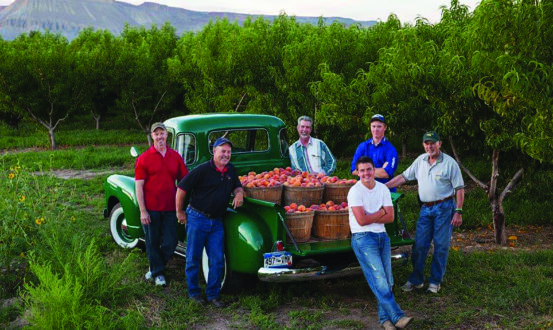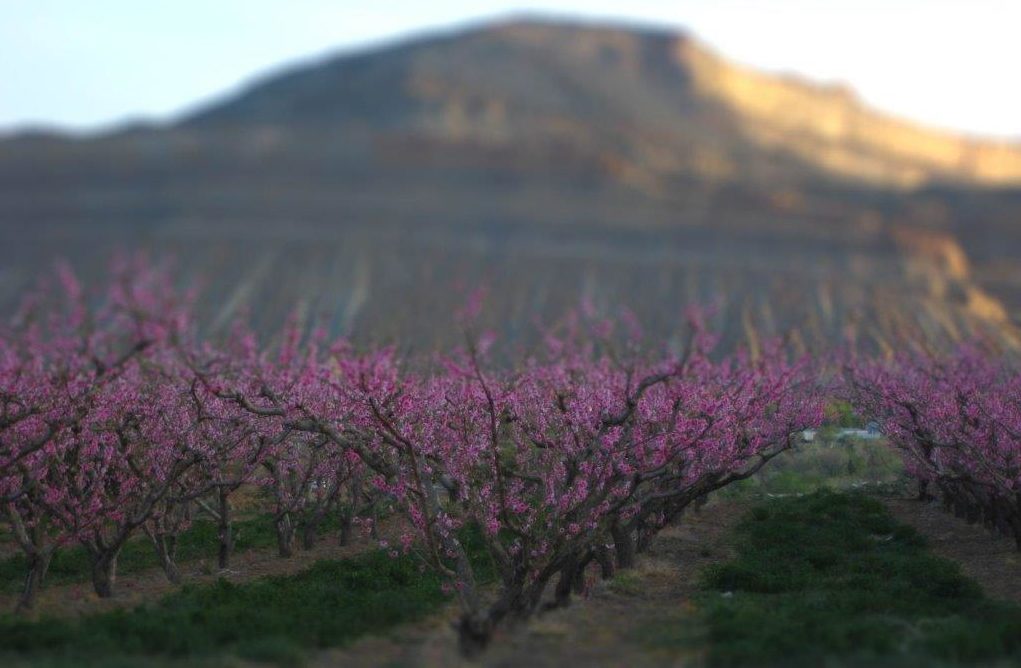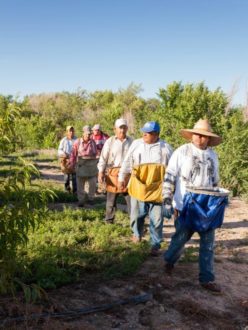

May 15, 2019Colorado peach growers tout elevation-enhanced sunlight
Talbott’s Mountain Gold Farm is located in Palisade, Colorado, which is west of Denver and just slightly east of Grand Junction. The operation’s packing/processing facilities and retail market are located on Palisade’s fruit and wine byway and attract visitors from long distances.
Taking the lead from their father, Harry Talbott, Bruce Talbott and his brothers have built the family’s strong farming foundation into a diverse agricultural operation that produces peaches, pears, cherries, winegrapes, juices and ciders – sweet and hard. Bruce Talbott was a speaker at the Michigan Spring Peach Meeting held in March in Benton Harbor, Michigan.
Talbott’s great-grandfather started planting peaches in 1907. The current business was incorporated by his grandfather in 1962.
“I enjoy the opportunity to work with my brothers,” Bruce Talbott said. “I enjoy having a common purpose and a common goal.”
It is a fifth-generation operation (with a sixth generation taking shape with more youngsters entering the business).
“As far as family succession, it’s really the third generation, because it went from my grandfather to my dad. Myself and my three brothers and our kids are following behind us,” Talbott said.
“I take care of everything that’s in the farm. My brother, Nathan, takes care of packing and processing, and brother Charlie does sales, logistics, banking, accounting, legal and all of the business end of it.”
Bruce said a fourth brother, David, went into the medical profession, “but he’s coming back to help us with his passion and putting together a wine program.”
The farm currently has 360 acres of peaches, 160 acres of winegrapes, eight acres of pears and a couple acres of cherries.
“We have ground we own and farm and ground that we lease through mostly profit-share agreements that are on usually 15-year leases,” Talbott said. “We have ground we take over at harvest and do custom harvesting into our shed, and pack for other growers as well.”
Talbott said there are “all kinds of increments within the organization. We’ve been making fresh apple juice since 1983. We added hard cider three years ago as the kids came back and wine is brand new.”
“We dropped over 200 tons of winegrapes last year,” he said. “We decided if we have grapes we don’t have a market for, we ought to get some kind of value out of it.”
Above: From the left are Nathan, Bruce, Charlie, Trevor, Joe (foreground) and Harry Talbott. Photos: Talbott’s Mountan Gold Farm.
Ripe peach climate


The Colorado peach industry consists of approximately 2,400 acres.
“We’re farming at 4,800 feet, which is below the top of the industry that is about 6,300 feet. Mesa and Delta counties do the majority of the peaches. Delta County does a better job with apples, we tend to do a better job with peaches (in Mesa County), but both counties grow both crops.”
For over a century, Talbott said, Colorado peaches have been known for their exceptional flavor and eating quality.
“Our peaches grow at a high altitude of 4,800 feet above sea level and receive an abundance of elevation-enhanced sunshine,” he said. “Cool, arid nights and warm, long days contribute to the exceptional flavor of the fruit.”


Peach production is aided by the snowmelt from the Rocky Mountains that flow into the valley, picking up nutrients along the way. The rich blend of natural minerals supplied by the cool mountain waters and alluvial soils are drawn up by the roots of the trees, travel through the branches and are delivered to the ripening fruit.
The farm grows as many as 30 different varieties, including Cresthaven, Glohaven and Red Glow, which Talbott said make up 50 percent of the Colorado industry.
“I really like the hard, red peaches out of California, like Zee Lady and Sierra Rich – but its hard, red genetics give it high susceptibility to phytophthora root and crown rot,” Talbott said. “I lost a 4-year-old, 6-year-old and 8-year-old block of Zee Lady and Sierra Rich. We had two winters of zero temperatures and below. Phytophthora just took those blocks out after those two winters.”
The farm grows a lot of Michigan, Southeastern and California varieties, he said.
“We seem to be able to mix a lot of different things in our area. We don’t get some of the diseases when we use the California’s but the Michigan and East Coast varieties tend to be more durable fruit. “Because of our elevation, we get more color,” Talbott said. “You can take a Suncrest – it’s a 50% red peach – Resthaven a 30-50% red peach. You take that same thing to California, and it’s a yellow. You can’t do anything with it as a red peach there.”
Labor in flux


Talbott’s Farm competes for labor most directly with the gas industry and construction.
“We’re not different than anybody else,” Talbott said. “At this point, we’re predominantly H-2A. We tried to start H-2A in about 2000. At that point, the state of Colorado said there was not a need and would not certify us, so we couldn’t access the program. Four or five years later, they said ‘OK, we get it, you guys can’t get any help.’”
“So we went into H-2A,” he said. “It was a steep learning curve. It’s an onerous program designed to fail. I don’t believe it was ever intended to work. We were in it for five years, then the Obama administration was basically discouraging use of the program.”
The farm endured a rigorous six-week audit. “In the end, the majority of our violations were (from) changes in the rules we didn’t even know existed,” Talbott said. “We dropped out for three years because there was just too big of a target on our backs. When we went out, we sucked up all of the local labor and everyone else had to go into H-2A. But they were somehow below the radar.”
After three years, Talbott Farms determined “we couldn’t operate without viable harvest labor. So, this is our fifth-year back in. I have 40 guys who come in February 1, and they go home October 15. I have about 10 guys who work year-round in the interim.”


Although Talbott still maintains H-2A is an onerous program, it does seem consistent. “In probably about 250 contracts I’ve had, two (H-2A) people did not finish the program. For corresponding workers that were not already full-time, I have had two people stay. They were two people I liked that we put on equipment.
“H-2A workers are good workers,” Talbott said. “They want to come back. We treat them very well. They treat us very well. It has made it viable for us to keep farming, even though we’re $13.13 an hour (Adverse Effect Wage Rate).”
Talbott described how peach production has gone from stilts that were used for thinning and pruning years ago, to conducting orchard work on ladders with hand shears.
“For blossom thinning, we used ropes for a while. (Fruit) size is absolutely critical. If we can’t get size we use things like the Darwin String Thinner. I tell them to go fast, strip and leave me three times the crop.”
– Gary Pullano, managing editor














